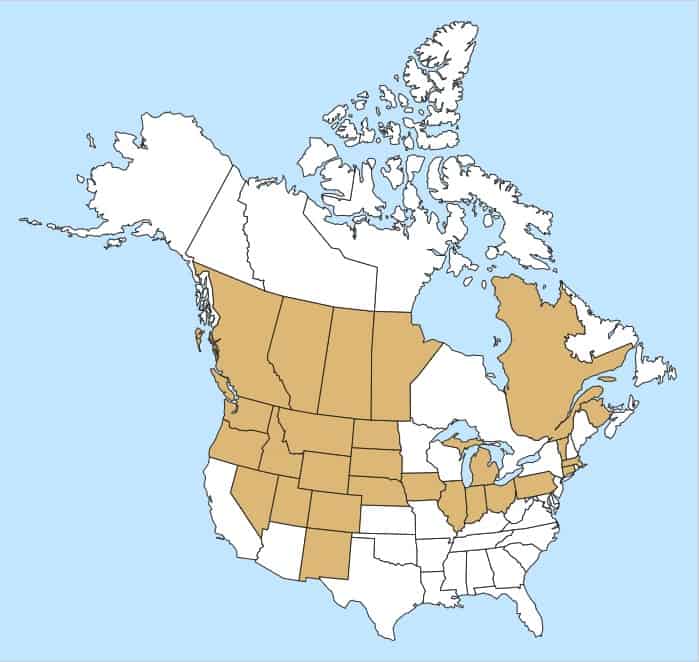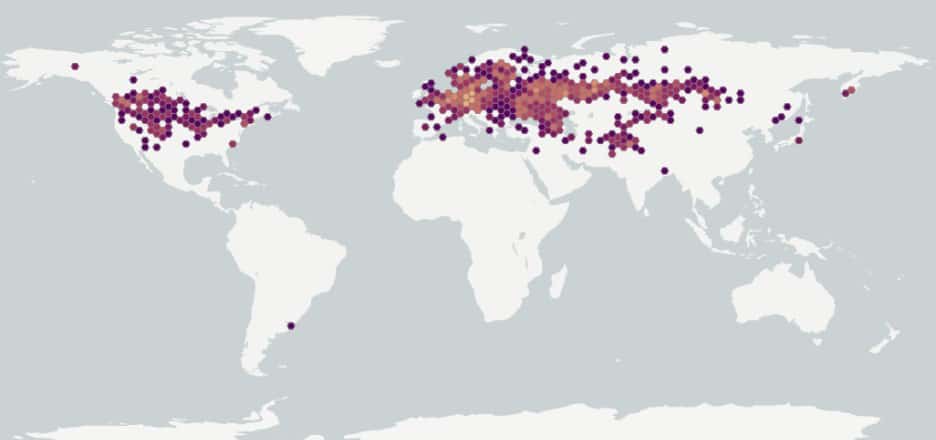Sisymbrium loeselii
Overview
Aperçu
Regulation :
Remarques Réglementation:
- CFIA Weed Seeds Order - Class 3: Secondary Noxious Weed Seeds
Regulation Notes:
Distribution :
Répartition :
Native to parts of central and eastern Europe and temperate Asia. Introduced throughout much of Europe as well as in North America, South America, and Japan (FNA 1993+; USDA-ARS 2021). In the United States, found in many states except for some in the south (USDA-NRCS 2021). Occurs in Alberta, British Columbia, Manitoba, Northwest Territories, Ontario, Quebec and Saskatchewan in Canada (Brouillet et al. 2010+).
Habitat and Crop Association :
Habitat et Cultures Associées :
Cultivated fields, old fields, field margins, pastures, stream banks, vacant lots, roadsides, railway lines and disturbed areas (FNA 1993+; Frankton and Mulligan 1993; Darbyshire 2003).
Economic Use, cultivation area, and Weed Association :
Utilisation économique, zone de culture et association de mauvaises herbes :
Duration of Life Cycle :
Durée du cycle vital:
Annual
Dispersal Unit Type :
Type d’unité de dispersion :
Seed
General Information
RENSEIGNEMENTS GÉNÉRAUX
Sisymbrium loeselii plants have a competitive edge in rangelands as they produce chemicals capable of inhibiting germination and growth of nearby plants (Bainard et al. 2009).
.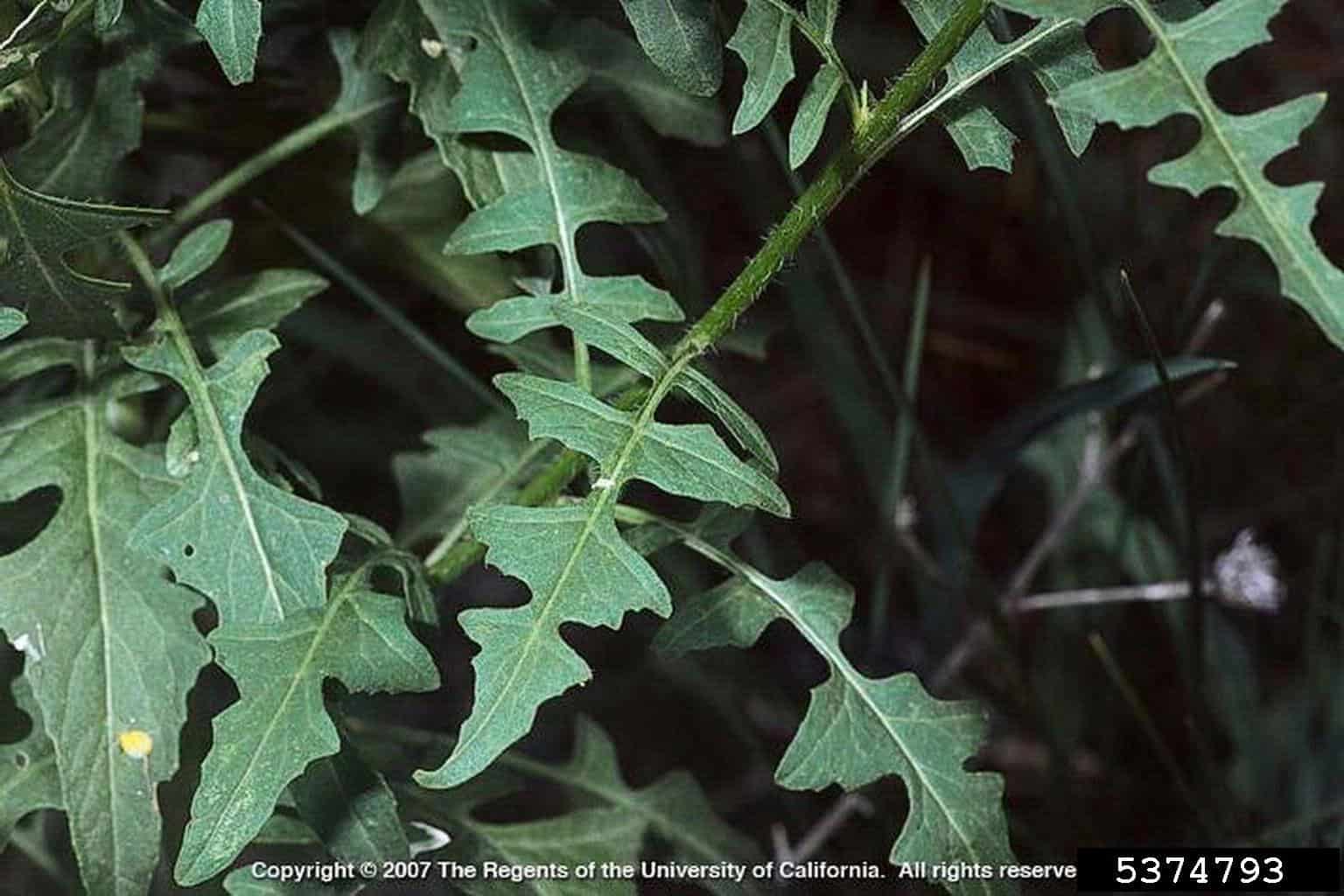
Sisymbrium loeselii foliage (Joseph M. DiTomaso, University of California – Davis, Bugwood.org)
Identification
Identification
-
Silique
Size
- Silique length: 20.0 – 35.0 mm long; width: 0.9 – 1.1 mm (FNA 1993+)
Shape
- Silique is narrowly linear, can be straight or curved on the longitudinal axis, with transverse constrictions
Surface Texture
- Silique surface is smooth
Colour
- Silique is dull straw yellow
Other Features
- Silique is shiny green when immature
- 40 – 60 seeds per pod (FNA 1993+)
- A persistent style remnant at one end of the silique 0.3 – 0.7 mm long (FNA 1993+)
-
Seed
Size
- Seed length*: 0.6 – 1.0 mm; width: 0.4 – 0.6 mm
*Note: minimum and maximum of 10 seeds in a normal range of this species using image measurement (ISMA 2020)
Shape
- Oblong shaped seed, with a round and a truncate end
Surface Texture
- Seed generally smooth with some wrinkles
Colour
- Seed glossy, yellow coloured, dark orange at the end with the hilum
Other Features
Hilum & Hilum area
- The hilum end is truncate, the radicle generally extends past the end
- A groove from the hilum area between radicle and cotyledons, extends almost to the other end of the seed
Other than hilum
- The seed end opposite the hilum is round or angled
- Seed is not mucilaginous when wetted (FNA 1993+)
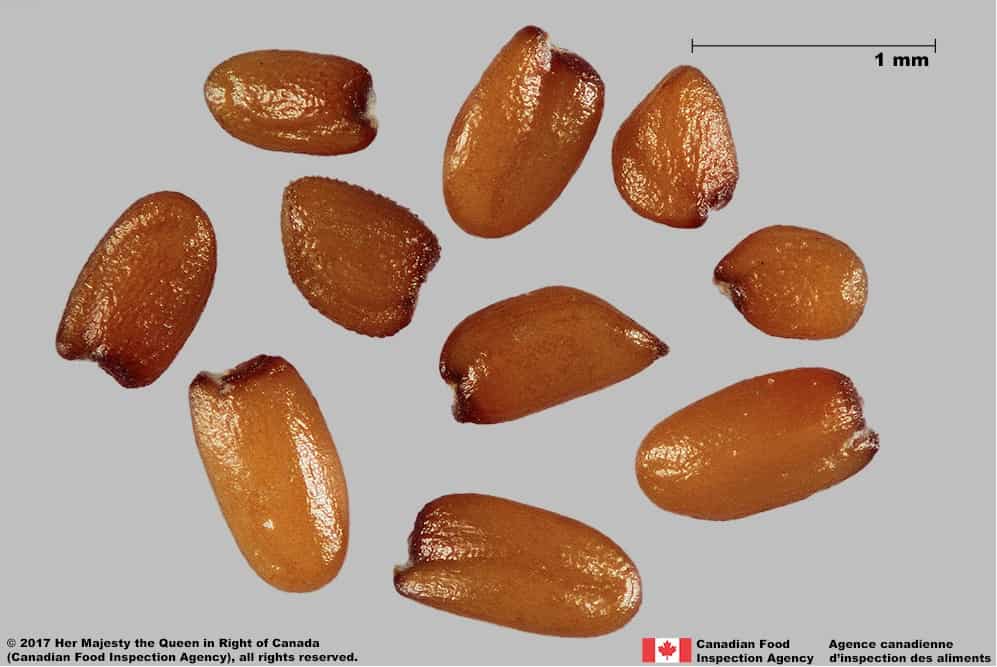
Tall hedge mustard (Sisymbrium loeselii) seeds

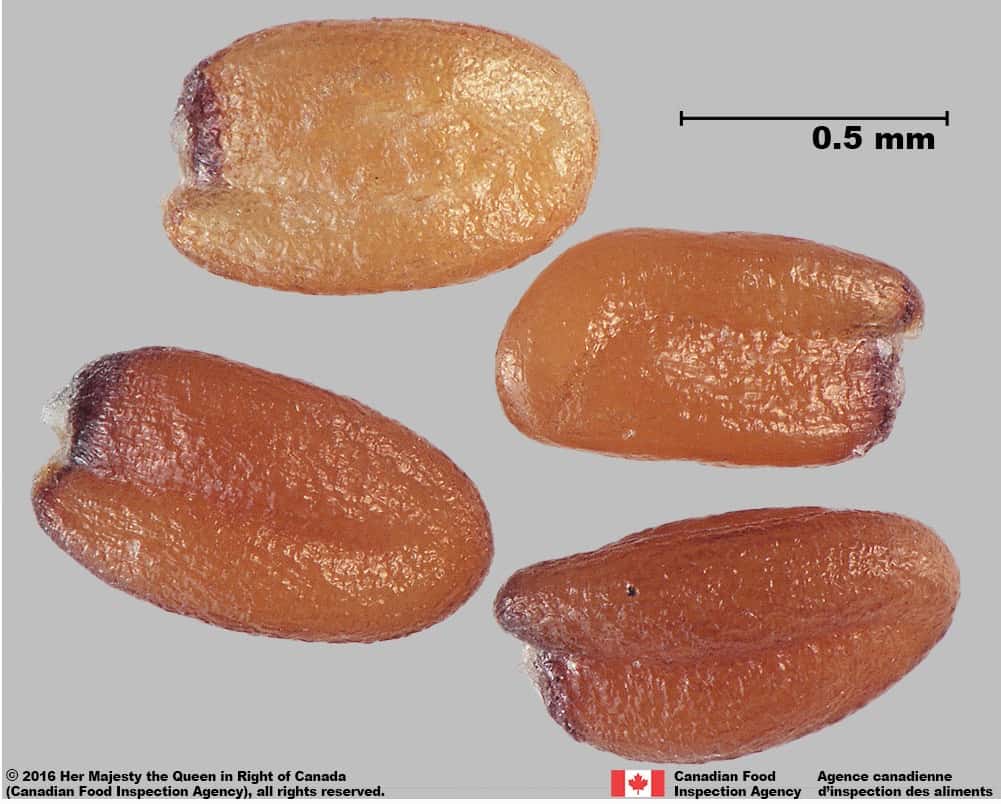
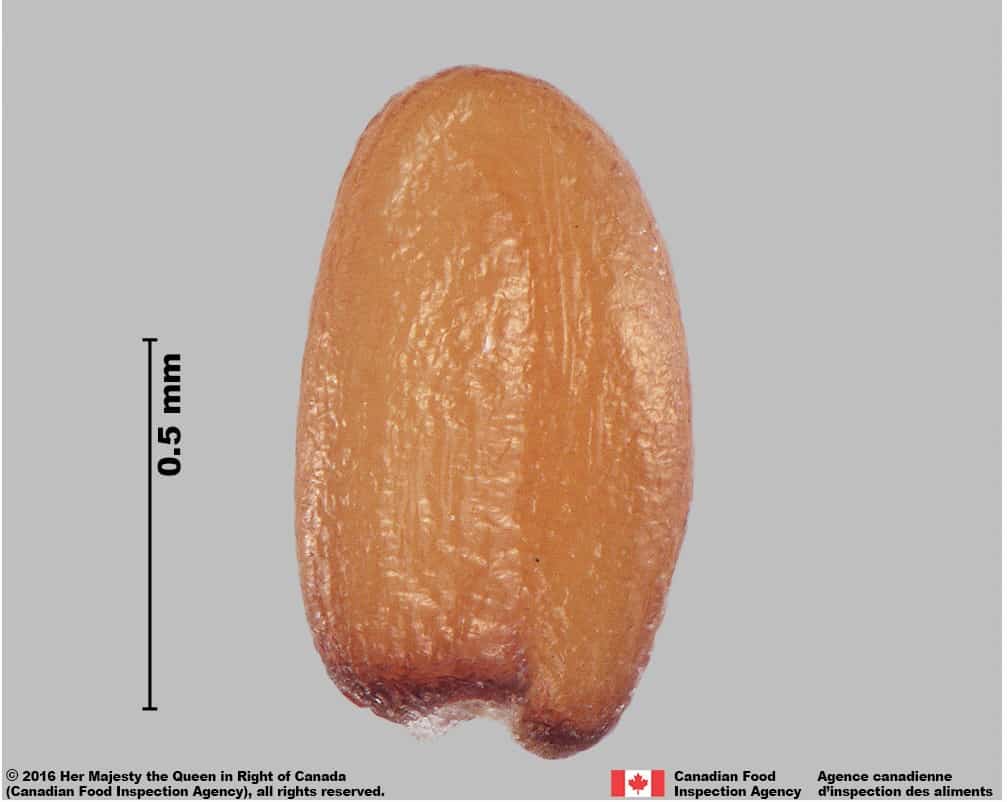
-
Embryo
Size
- Embryo fills the seed
Shape
- Embryo is bent
Endosperm
- Endosperm is scant or lacking, nutritive tissue contained within cotyledons
Other Features
- Cotyledons are oval shaped, soft and light yellow coloured
Identification Tips
CONSEILS POUR L’IDENTIFICATION
Seeds of species in the Brassicaceae that have oblong shape with a radicle groove include Sisymbrium species, Descurainia species, Erucastrum gallicum and Capsella bursa-pastoris. Seeds of Sisymbrium loeselii can be distinguished from these similar genera by a smooth surface and glossy yellow colour. S. loeselii can be distinguished from other Sisymbrium species by the same features, plus the radicle extends past the hilum end.

Tall hedge mustard (Sisymbrium loeselii) seed



Additional Botany Information
AUTRES RENSEIGNEMENTS BOTANIQUES
Similar Species
ESPÈCES SEMBLABLES
Similar species are based on a study of seed morphology of various species, and those with similar dispersal units are identified. The study is limited by physical specimen and literature availability at the time of examination, and possibly impacted by the subjectivity of the authors based on their knowledge and experience. Providing similar species information for seed identification is to make users aware of similarities that could possibly result in misidentification.
Sisymbrium altissimum L. (tumble mustard)
S. altissimum seeds are generally larger (length *: 0.5 – 0.8 mm; width 0.5 – 0.7 mm) than S. loeselii, have a ridged reticulate surface and are shiny reddish-brown coloured compared to the wrinkled surface and glossy yellow colour of S. loeselii . The radicle does not extend past the end of the seed, unlike S. loeselii.
*Note: minimum and maximum of 10 seeds in a normal range of this species using image measurement (ISMA 2020)
Click to select species
Cliquez pour sélectionner les espèces
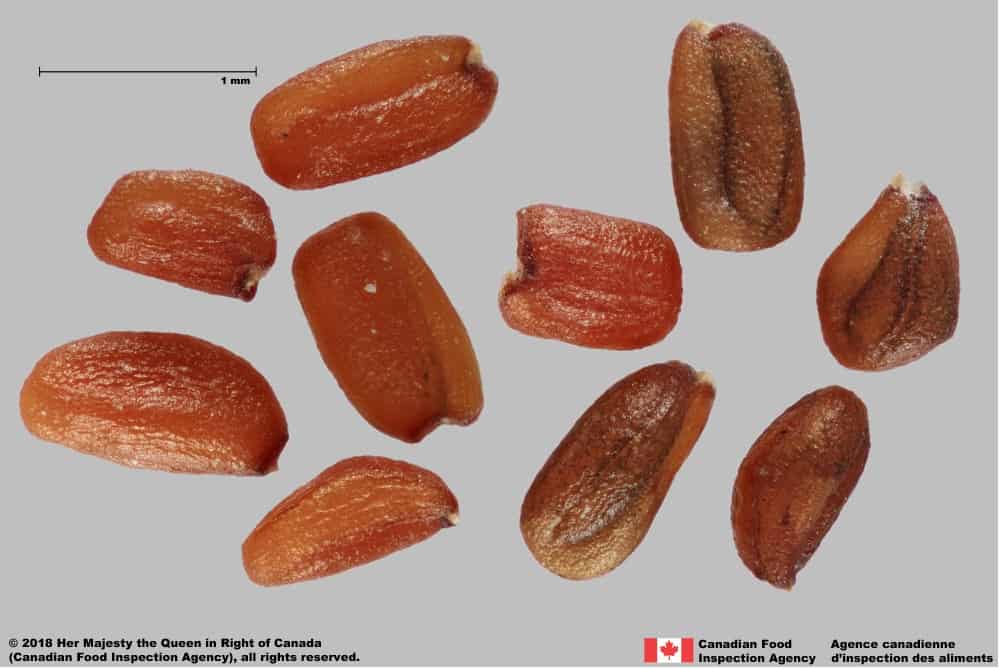
Sisymbrium altissimum
Comparison Window
Fenêtre de comparaison
MAIN SPECIES
ESPÈCES PRINCIPALES
Sisymbrium loeselii

Sisymbrium loeselii
Brassicaceae
Tall hedge mustard (Sisymbrium loeselii) seeds
MAIN SPECIES
ESPÈCES PRINCIPALES
Sisymbrium loeselii

Sisymbrium loeselii
Brassicaceae
Tall hedge mustard (Sisymbrium loeselii) seeds
MAIN SPECIES
ESPÈCES PRINCIPALES
Sisymbrium loeselii

Sisymbrium loeselii
Brassicaceae
Tall hedge mustard (Sisymbrium loeselii) seed
SIMILAR SPECIES
ESPÈCES SEMBLABLES
Sisymbrium altissimum

Sisymbrium altissimum
Brassicaceae
Tumble mustard (Sisymbrium altissimum) seeds
SIMILAR SPECIES
ESPÈCES SEMBLABLES
Sisymbrium altissimum
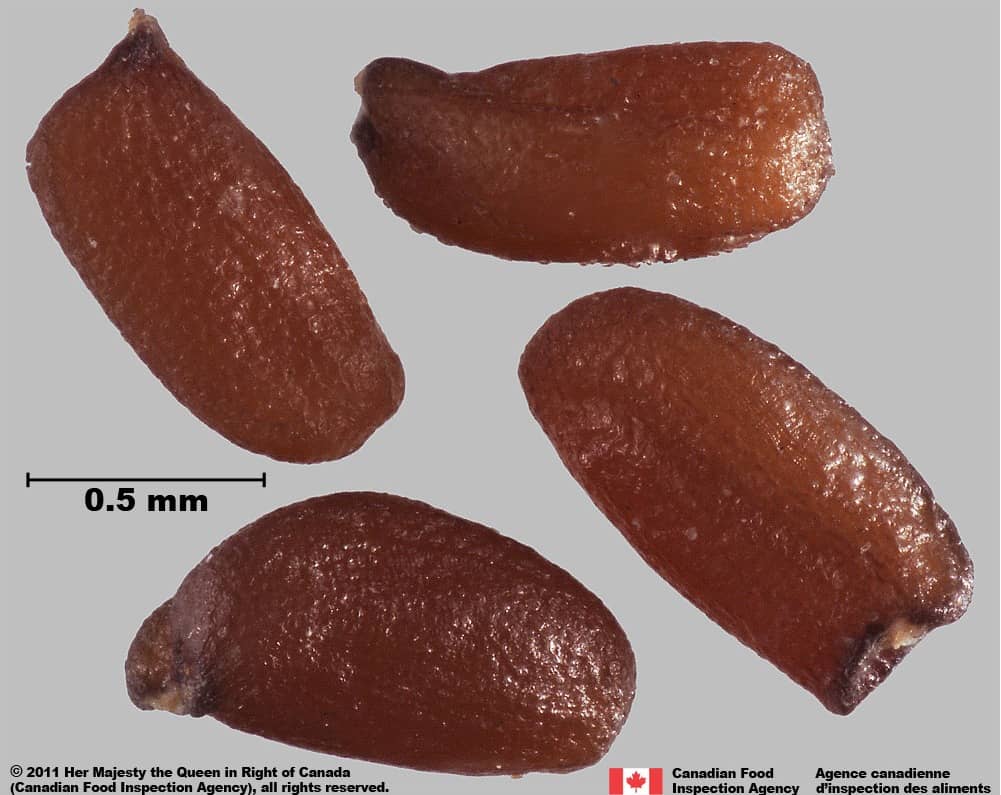
Sisymbrium altissimum
Brassicaceae
Tumble mustard (Sisymbrium altissimum) seeds
SIMILAR SPECIES
ESPÈCES SEMBLABLES
Sisymbrium altissimum
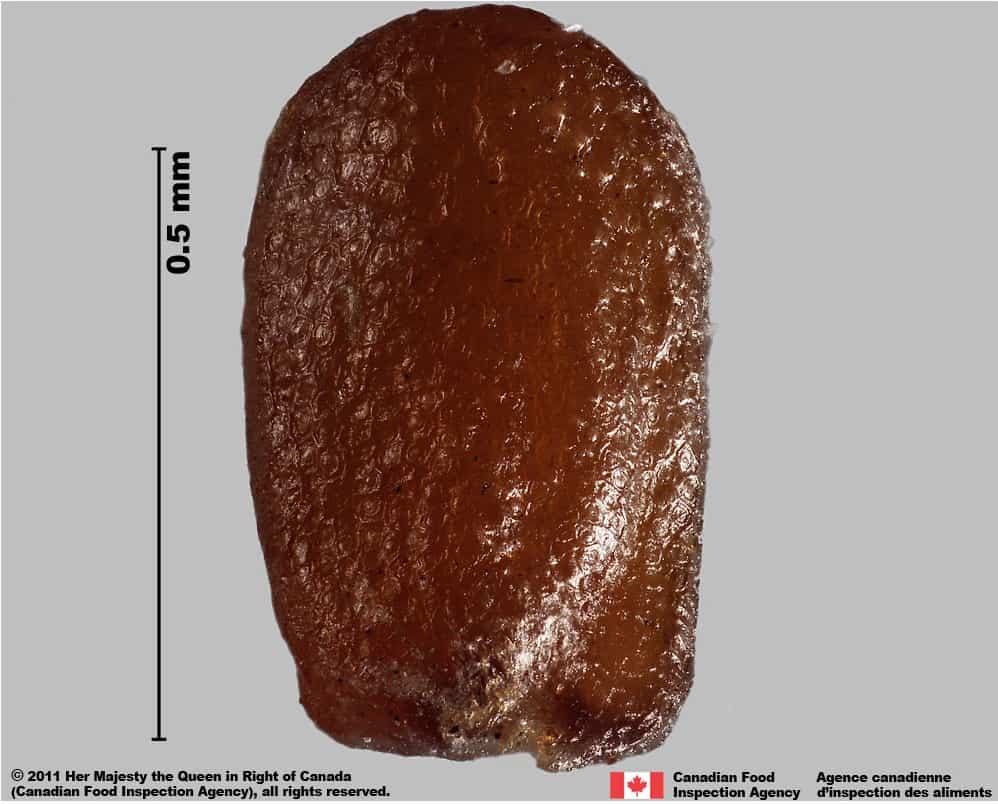
Sisymbrium altissimum
Brassicaceae
Tumble mustard (Sisymbrium altissimum) seed
Need ID Help?
Besoin d’aide pour l’identification?
Reference(s)
Référence(s)
Bainard, L., Brown, P. D. and Upadhyaya, M. 2009. Inhibitory effect of tall hedge mustard (Sisymbrium loeselii) allelochemicals on rangeland plants and arbuscular mycorrhizal fungi. Weed Science, 57: 386-393.
Brouillet, L., Coursol, F., Meades, S. J., Favreau, M., Anions, M., Bélisle, P. and Desmet, P. 2010+. VASCAN, the database of vascular plants of Canada. http://data.canadensys.net/vascan/ Accessed April 27, 2021.
Darbyshire, S. J. 2003. Inventory of Canadian Agricultural Weeds. Agriculture and Agri-Food Canada, Research Branch. Ottawa, ON.
Flora of North America (FNA) Editorial Committee, eds. 1993+. Flora of North America North of Mexico [Online]. 22+ vols. New York and Oxford. Accessed December 29, 2022.
Frankton, C. and Mulligan, G. A. 1993. Weeds of Canada. Agriculture Canada, Publication 948.
Global Biodiversity Information Facility (GBIF) Secretariat. 2022. https://doi.org/10.15468/39omei Accessed via https://www.gbif.org/species/3046875 Accessed December 29, 2022.
Government of Canada (GC). 2016. Canadian Weed Seeds Order. https://laws-lois.justice.gc.ca/eng/regulations/SOR-2016-93/page-2.html (English) https://laws-lois.justice.gc.ca/fra/reglements/DORS-2016-93/page-2.html (French)
International Seed Morphology Association (ISMA). 2020. Method for Seed Size Measurement. Version 1.0. ISMA Publication Guide.
U.S. Department of Agriculture-Agricultural Research Services (USDA-ARS). 2021. Germplasm Resources Information Network (GRIN), https://npgsweb.ars-grin.gov/gringlobal/taxon/taxonomysimple.aspx Accessed April 27, 2021.
U.S. Department of Agriculture-Natural Resources Conservation Service (USDA-NRCS). 2021. The PLANTS Database. National Plant Data Team, Greensboro, NC USA. http://plants.usda.gov Accessed April 27,2021.



